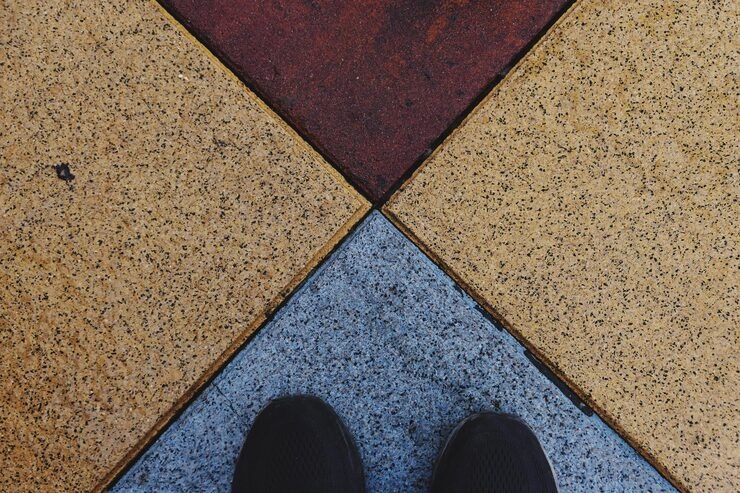Rubber tiles are increasingly popular as a flooring option because they combine durability, safety, and comfort. Made from natural or synthetic rubber, often recycled materials, these tiles are resilient under heavy usage, forgiving to falls, resistant to water, and comfortable underfoot. They’re used widely in gyms, children’s play areas, schools, commercial kitchens, and even outdoor patios. The modular form (tiles, interlocking systems, or rolls) makes them adaptable and suitable for varied layouts and spaces.
In recent years, design improvements have added aesthetic versatility to rubber tiles. No longer limited to purely functional appearances, they now come in diverse colors, patterns, and textures. Eco-friendly manufacturing and easier maintenance are also becoming key draws for both residential and commercial users. With increasing attention to sustainability and long-term cost savings, rubber tile flooring is emerging as a viable alternative to traditional floorings such as tiles, wood, or vinyl.

Importance of Rubber Tiles in Flooring Solutions
Rubber tiles offer several advantages that make them well-suited for both high-traffic and sensitive areas. Their shock-absorbing nature reduces fatigue and risk of injury, making them ideal for gyms, play areas, and workplaces where people stand for long periods. Their slip resistance—even when wet—makes them safer than many hard surface options.
Beyond safety, durability is a major strength. Rubber flooring resists wear, staining, water damage, and can retain its performance for decades. These features translate into lower maintenance costs and less frequent replacement, offering long-term value. Noise dampening and thermal comfort are additional benefits, especially in multi-story buildings or spaces where acoustic control matters.
Recent Trends & Developments (2024–2025)
-
Use of recycled rubber (such as from old tires) to make tiles, improving sustainability.
More color and texture variety—designers now get rubber in many finishes, patterns, and tile formats.
-
Preference for interlocking and modular tile systems that simplify installation and replacement of individual tiles.
-
Increased adoption in commercial settings (gyms, schools, healthcare) and in outdoor/semi-outdoor areas due to water resistance and durability.
Laws, Safety & Standards to Be Aware Of
-
Flooring in public/commercial spaces often needs certifications for slip resistance and fire safety.
-
Low VOC (volatile organic compounds) rubber formulations are increasingly required for indoor air quality.
-
Environmental regulations may favor recycled content or eco‐friendly manufacturing processes.
-
Building codes may dictate suitability for wet areas, moisture barriers, and installation standards.
Tools, Types & Resources for Rubber Tile Flooring
| Type/Resource | Description & Use Case |
|---|---|
| Interlocking Rubber Tiles | Best for gyms, play areas, spaces where easy replacement of parts is useful. |
| Loose-Lay Tiles or Rolls | For larger spaces or continuous flooring with fewer seams. |
| Textured vs Smooth Surface | Textured provides better slip resistance; smooth is easier to clean. |
| Color/Pattern Options | Match interior design; use accent tiles. |
| Cleaning & Maintenance Tools | Mild detergent, mop, non-abrasive cleaners. |
| Recycled Rubber Suppliers | For eco-friendly, cost-effective material sources. |
Comparison Table: Rubber Tiles vs Other Flooring Types
| Feature | Rubber Tiles | Ceramic/Porcelain Tiles | Hardwood/Vinyl Flooring |
|---|---|---|---|
| Durability | High resistance to impacts, wear | Can crack, heavy | Wear surfaces may scratch |
| Slip Resistance | Excellent, especially textured | Needs special treatments | Varies, risky when wet |
| Comfort underfoot | High cushioning, fatigue reducing | Hard, cold | Moderate, depends on underlay |
| Maintenance | Sweeping, occasional mopping | Grout cleaning, sealing required | Sensitive to water and stains |
| Water Resistance | Very good, moisture resistant | Very good, but grout is issue | Poor if exposed without protection |
| Design Variety | Wide color/textures, modular formats | Many styles, fixed size | Many finishes, variation in price |
Practical Checklist Before Installing Rubber Tiles
-
Check base floor is clean, level, and dry
-
Measure the space accurately and consider layout pattern
-
Choose tile thickness & density suitable for load / traffic
-
Prefer textured/safe surface for wet or outdoor areas
-
Confirm fire rating & slip resistance class
-
Select eco‐friendly or recycled rubber if sustainability is a priority
-
Plan maintenance—cleaning routines, possibly resealing seams if necessary
FAQs
Q1. Are rubber tiles suitable for bathrooms or wet areas?
Yes, many rubber tiles are moisture resistant and have slip-resistant textures. But it’s important to seal seams and use suitable adhesives if required.
Q2. Do rubber tiles have odor after installation?
Some products may have a slight rubber smell initially. Good ventilation and selecting low-VOC or well cured rubber reduces this significantly.
Q3. How long do rubber tiles last?
With proper installation and maintenance, rubber tiles can last 20 years or more in high traffic areas. Avind Sports Flooring Systems -+1
Q4. How does rubber flooring compare cost-wise?
Upfront cost may be higher than basic vinyl or laminate, but due to durability and low maintenance, lifetime cost tends to be favorable.
Q5. Can damaged rubber tiles be replaced individually?
Yes, modular/rubber tile systems allow for replacing damaged tiles without redoing entire floor.
Conclusion
Rubber tiles are a versatile, durable, and safe flooring solution that works well across residential, commercial, and industrial settings. They offer significant benefits: shock absorption, slip resistance, long life, and design flexibility. While initial cost or odor might be considerations, proper product choice and installation mitigate these issues. For anyone seeking flooring that balances practicality, comfort, and longevity, rubber tile solutions present an excellent choice.